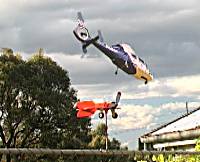
|
The world of non-commercial film and A-V |
Events Diary | Search | ||
| The Film and Video Institute | | ||||
The making of The Little Aeroplane
Meet ... John Sirett
whose film The Little Aeroplane won a Silver Standard Award at BIAFF 2007
I guess I have to categorize myself as an "event photographer" because I don't do drama or screenplays, or any other genre where it is possible to pre-plan the film and work to a storyboard and script. Also I don't know any actors who I could ask to work for me and finally, I prefer to work alone.
 So, for me, The Little Aeroplane is something
of an exception. The story was dreamt up over a period of about twelve months
(usually at night in bed) then committed to paper the following day - if
I could remember.
So, for me, The Little Aeroplane is something
of an exception. The story was dreamt up over a period of about twelve months
(usually at night in bed) then committed to paper the following day - if
I could remember.
Actually I tell a lie. I did attempt a horror movie some years ago using my family as actors. It failed miserably in competition, but did gain complete agreement from the judges. They all thought it was horrible.
I have always held a fascination for visual effects and The Little Aeroplane was to be a way of dabbling in the art of visual deception. So I painted the inside of my garage door blue, rubbed my hands together gleefully and dived headlong into chroma keying.
I soon learned a thing or two.
To make a chroma key stage requires a lot of s p a c e. The 'blue screen' has to be illuminated evenly and independently of the subject and the subject's lighting is not to create a shadow on the blue screen. To achieve this I had to locate the camera several meters back from the garage door.
Then, to have the aeroplane appear small in size on the monitor, a wide camera angle was required and my garage door 'blue screen' simply was not wide enough to accommodate the shot !
 I overcame the space problem by photographing the aeroplane
at each required angle and printing off a small picture which I attached
directly on to my blue screen. This way I had plenty of blue screen available
to zoom, pan and manoeuvre the aeroplane as the story required.
I overcame the space problem by photographing the aeroplane
at each required angle and printing off a small picture which I attached
directly on to my blue screen. This way I had plenty of blue screen available
to zoom, pan and manoeuvre the aeroplane as the story required.
The next thing I learned was that ideally, a subject for chroma keying should be large (occupying at least one third of the TV screen), should have a clear, clean and solid outline and not have any colour that conflicted with the 'key' colour.
My choice of a small aeroplane with a rotating propeller was far from ideal and the thin wings suffered from 'rasterization' on the TV screen when viewed head on .
In addition I had trouble in keying-out my subject cleanly. This I found was due to the blue paint on my garage door. I had purchased a recommended "chroma-key blue", but found by colour matching on my computer that it had a red component in its make-up.(I suspect this paint may have been formulated for use in the film industry using wratten filters for keying) So I changed my key colour to a pure green (255 on the RGB scale) and had much more success.
An absorbing aspect of the aeroplane chroma-keying was filming the backgrounds.
To create the effect of the aeroplane moving, the background scene had to move too and both shots had to be synchronized to be believable. It took me many attempts to get the 'just right' background for the 'plane looping the loop over the Sydney Opera House. I did this by counting out aloud while describing circles with my Canon XM1 camcorder on its tripod. Onlookers were intrigued by my behaviour and I was able to capture, with my palmcorder, some of their curiosity and use it.
 Another challenge arose when I wanted a shot taken from the
little aeroplane flying over the city buildings. It happened that a model
of Sydney CBD [Central Business District - Ed.] had been built under a glass
floor for public viewing. So I built a little two wheeled cart and mounted
my Sony TRV19 palmcorder with its lens very close to the floor (to avoid
reflections) and walked to and fro across the exhibit to record my shot.
The viewing public, of course, thought I was some kind of nut case and there
was a good deal of comment made.
Another challenge arose when I wanted a shot taken from the
little aeroplane flying over the city buildings. It happened that a model
of Sydney CBD [Central Business District - Ed.] had been built under a glass
floor for public viewing. So I built a little two wheeled cart and mounted
my Sony TRV19 palmcorder with its lens very close to the floor (to avoid
reflections) and walked to and fro across the exhibit to record my shot.
The viewing public, of course, thought I was some kind of nut case and there
was a good deal of comment made.
Regarding the story and the content, I was influenced by "Thomas the Tank Engine" format, but using a local scenario and intended for local consumption. I expect most of the political innuendo would 'pass through to the keeper' in countries other than Australia, It was not really intended to be just for the kiddies.
- John Sirett
Read John's article on his Gold Award winner Spider! - click here.
Share your passions.

Share your stories.